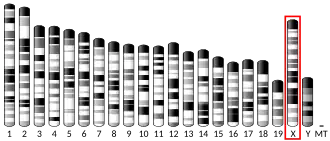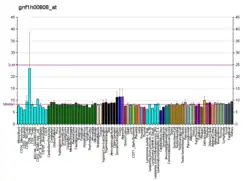Probable G-protein coupled receptor 174 is a protein that in humans is encoded by the GPR174 gene.[5]
Ligands
- Agonists
- Antagonists
- N-acyl derivatives of LysoPS act as antagonists at GPR174.[8]
References
- ^ a b c GRCh38: Ensembl release 89: ENSG00000147138 – Ensembl, May 2017
- ^ a b c GRCm38: Ensembl release 89: ENSMUSG00000073008 – Ensembl, May 2017
- ^ "Human PubMed Reference:". National Center for Biotechnology Information, U.S. National Library of Medicine.
- ^ "Mouse PubMed Reference:". National Center for Biotechnology Information, U.S. National Library of Medicine.
- ^ "Entrez Gene: GPR174 G protein-coupled receptor 174".
- ^ Liu G LX (Dec 2023). "Structural basis for ligand recognition and signaling of the lysophosphatidylserine receptors GPR34 and GPR174". PLOS Biology. 21 (12): e3002387. doi:10.1371/journal.pbio.3002387. PMC 10721165. PMID 38048360.
- ^ Nie Y, Qiu Z, Chen S, Chen Z, Song X, Ma Y, et al. (Sep 2023). "Specific binding of GPR174 by endogenous lysophosphatidylserine leads to high constitutive Gs signaling". Nature Communications. 14 (1) 5901. doi:10.1038/s41467-023-41654-3. PMC 10516915. PMID 37737235.
- ^ Sayama M, Uwamizu A, Ikubo M, Chen L, Yan G, Otani Y, et al. (July 2021). "Switching Lysophosphatidylserine G Protein-Coupled Receptor Agonists to Antagonists by Acylation of the Hydrophilic Serine Amine". Journal of Medicinal Chemistry. 64 (14): 10059–10101. doi:10.1021/acs.jmedchem.1c00347. PMID 34233115.
Further reading




